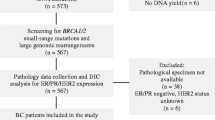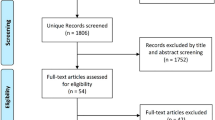Abstract
Background
Mutations in BRCA1 and BRCA2 confer an increased risk to breast and other cancers, but to date there have only been limited numbers of studies of BRCA1- and BRCA2-associated cancers among Asians. Malaysia is a multiracial country with three main races: Malays, Chinese, Indians. We determined whether tumor pathologic features and clinical features differ in patients with and without BRCA mutations in this Asian population.
Methods
We conducted a retrospective review of the medical records of 152 women with breast cancer who underwent genetic testing for BRCA mutations. The patients self-reported ethnicity, age at onset, and clinical stage at diagnosis and tumor pathology were reviewed.
Results
A total of 31 patients carried germline deleterious mutations (16 BRCA1, 15 BRCA2). We found that tumors in BRCA1 carriers were more likely to be estrogen receptor (ER)-negative and progesterone receptor (PR)-negative. HER2 was more likely to be negative in both BRCA1 and BRCA2 subjects compared with non-BRCA subjects. We found a strong association between triple-negative status and BRCA1 carriers. In addition, tumors in BRCA1 carriers were more likely to be higher grade than those in BRCA2 and non-BRCA carriers; but the difference was not statistically significant.
Conclusions
These results suggest that tumors associated with BRCA1 mutations are distinct from those of BRCA2-associated and non-BRCA-associated breast cancers, and that the tumors associated with BRCA2 mutations are similar to the non-BRCA-associated breast cancers. Further studies are required to determine if the prognosis is different in each of these groups and the best management strategy for each group.
Similar content being viewed by others
References
Yip CH, Taib NA, Mohamed I (2006) Epidemiology of breast cancer in Malaysia. Asian Pac J Cancer Prev 7:369–374
Minami Y, Tsubono Y, Nishino Y et al (2004) The increase of female breast cancer incidence in Japan: emergence of birth cohort effect. Int J Cancer 108:901–906
Toh GT, Kang P, Lee SS et al (2008) BRCA1 and BRCA2 germline mutations in Malaysian women with early-onset breast cancer without a family history. PLoS ONE 3:e2024
Thirthagiri E, Lee S, Kang P et al (2008) Evaluation of BRCA1 and BRCA2 mutations and risk-prediction models in a typical Asian country (Malaysia) with a relatively low incidence of breast cancer. Breast Cancer Res 10:R59
Purnomosari D, Pals G, Wahyono A et al (2007) BRCA1 and BRCA2 germline mutation analysis in the Indonesian population. Breast Cancer Res Treat 106:297–304
Rashid MU, Zaidi A, Torres D et al (2006) Prevalence of BRCA1 and BRCA2 mutations in Pakistani breast and ovarian cancer patients. Int J Cancer 119:2832–2839
Song CG, Hu Z, Wu J et al (2006) The prevalence of BRCA1 and BRCA2 mutations in eastern Chinese women with breast cancer. J Cancer Res Clin Oncol 132:617–626
Han SH, Lee KR, Lee DG et al (2006) Mutation analysis of BRCA1 and BRCA2 from 793 Korean patients with sporadic breast cancer. Clin Genet 70:496–501
Li WF, Hu Z, Rao NY et al (2008) The prevalence of BRCA1 and BRCA2 germline mutations in high-risk breast cancer patients of Chinese Han nationality: two recurrent mutations were identified. Breast Cancer Res Treat 110:99–109
Karp SE, Tonin PN, Begin LR et al (1997) Influence of BRCA1 mutations on nuclear grade and estrogen receptor status of breast carcinoma in Ashkenazi Jewish women. Cancer 80:435–441
Atchley DP, Albarracin CT, Lopez A et al (2008) Clinical and pathologic characteristics of patients with BRCA-positive and BRCA-negative breast cancer. J Clin Oncol 26:4282–4288
Brekelmans CT, Seynaeve C, Menke-Pluymers M et al (2006) Survival and prognostic factors in BRCA1-associated breast cancer. Ann Oncol 17:391–400
Stoppa-Lyonnet D, Ansquer Y, Dreyfus H et al (2000) Familial invasive breast cancers: worse outcome related to BRCA1 mutations. J Clin Oncol 18:4053–4059
Rennert G, Bisland-Naggan S, Barnett-Griness O et al (2007) Clinical outcomes of breast cancer in carriers of BRCA1 and BRCA2 mutations. N Engl J Med 357:115–123
Frank TS, Deffenbaugh AM, Reid JE et al (2002) Clinical characteristics of individuals with germline mutations in BRCA1 and BRCA2: analysis of 10, 000 individuals. J Clin Oncol 20:1480–1490
Rakha EA, Reis-Filho JS, Ellis IO (2008) Basal-like breast cancer: a critical review. J Clin Oncol 26:2568–2581
Liu ZB, Liu GY, Yang WT et al (2008) Triple-negative breast cancer types exhibit a distinct poor clinical characteristic in lymph node-negative Chinese patients. Oncol Rep 20:987–994
Reis-Filho JS, Tutt AN (2008) Triple negative tumors: a critical review. Histopathology 52:108–118
Cleator S, Heller W, Coombes RC (2007) Triple-negative breast cancer: therapeutic options. Lancet Oncol 8:235–244
Musolino A, Michiara M, Bella MA et al (2005) Molecular profile and clinical variables in BRCA1-positive breast cancers: a population-based study. Tumori 91:505–512
Foulkes WD, Metcalfe K, Sun P et al (2004) Estrogen receptor status in BRCA1- and BRCA2-related breast cancer: the influence of age, grade, and histological type. Clin Cancer Res 10:2029–2034
James PA, Doherty R, Harris M et al (2006) Optimal selection of individuals for BRCA mutation testing: a comparison of available methods. J Clin Oncol 24:707–715
Liede A, Malik IA, Aziz Z et al (2002) Contribution of BRCA1 and BRCA2 mutations to breast and ovarian cancer in Pakistan. Am J Hum Genet 71:595–606
Ang P, Lim IH, Lee TC et al (2007) BRCA1 and BRCA2 mutations in an Asian clinic-based population detected using a comprehensive strategy. Cancer Epidemiol Biomarkers Prev 16:2276–2284
De Leon Matsuda ML, Liede A, Kwan E et al (2002) BRCA1 and BRCA2 mutations among breast cancer patients from the Philippines. Int J Cancer 98:596–603
Author information
Authors and Affiliations
Corresponding author
Rights and permissions
About this article
Cite this article
Yip, CH., Taib, N.A., Choo, W.Y. et al. Clinical and Pathologic Differences Between BRCA1-, BRCA2-, and Non-BRCA-Associated Breast Cancers in a Multiracial Developing Country. World J Surg 33, 2077–2081 (2009). https://doi.org/10.1007/s00268-009-0146-8
Published:
Issue Date:
DOI: https://doi.org/10.1007/s00268-009-0146-8




